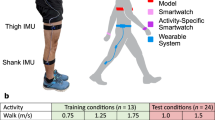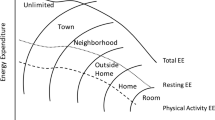Abstract
The relationship between activity counts from the large-scale integrated sensor (LSI), placed at the hip and ankle, and heart rate-estimated energy expenditure was examined in three nonobese males during three conditions: normal morning activities, a 1-mi walk, and a 2-mi walk. Results showed that estimated caloric expenditure was related to activity counts for both monitoring placements, with correlations between counts and energy expenditure exceedingr=.90. These results show that energy expenditure in the activities sampled can be reliably estimated using activity monitors.
Similar content being viewed by others
References
Andrews, R. B. (1971). Net heart rate as a substitute for respiratory calorimetry.American Journal of Clinical Nutrition, 24 1139–1147.
Astrand, I. (1971). Estimating the energy expenditure of housekeeping activities.American Journal of Clinical Nutrition, 24 1471–1475.
Astrand, P. O., & Rodahl, K. (1977).Textbook of work physiology. New York: McGraw-Hill.
Booyens, J., & Hervey, G. R. (1960). The pulse rate as a means of measuring metabolic rate in man.Canadian Journal of Biochemistry and Physiology, 38 1301–1309.
Bradfield, R. B., Huntzicker, P. B., & Fruehan, G. J. (1960). Simultaneous comparison of respirometer and heart rate telemetry techniques as measures of human energy expenditure.American Journal of Clinical Nutrition, 22 696–700.
Christensen, C. C., Frey, H. M. M., Foenstelien, E., Aadlund, E., & Refsum, H. E. (1983). A critical evaluation of energy expenditure estimates based on individual O2 consumption/heart rate curves and average daily heart rate.American Journal of Clinical Nutrition, 37 468–472.
Consolazio, C., Johnson, R., & Pecora, L. (1963).Physiological measurements of metabolic functions in man. New York: McGraw-Hill.
Foster, F. G., McPartland, R. J., & Kupfer, D. J. (1978). Motion sensors in medicine, Part 1. A report on reliability and validity.Journal of Inter-American Medicine, 3 4–8.
LaPorte, R. E., Cauley, J. A., Kinsey, C. M., Corbett, W., Robertson, R., Black-Sandler, R., Kuller, L. H., & Falkel, J. (1982). The epidemiology of physical activity in children, college students, middle-aged men, menopausal females and monkeys.Journal of Chronic Diseases, 35 787–795.
LaPorte, R. E., Kuller, L. H., Kupfer, D. J., McPartland, R. J., Matthews, G., & Casperson, C. (1979). An objective measure of physical activity for epidemiological research.American Journal of Epidemiology, 109 158–167.
McArdle, W., Katch, F., & Katch, V. (1981).Exercise physiology: Energy, nutrition, and human performance. Philadelphia: Lea and Febiger.
McPartland, R. J., Kupfer, D. J., & Foster, F. G. (1976). The movement-activated recording monitor: A third-generation motor-activity monitoring system.Behavior Research Methods and Instrumentation, 8 357–360.
Spady, D. W. (1980). Total daily energy expenditure of healthy, free ranging school children.American Journal of Clinical Nutrition, 33 766–775.
Tasto, D. I. (1977). Self-report schedules and inventories. In A. R. Ciminero, K. S. Calhoun, & H. E. Adams (Eds.),Handbook of behavioral assessment. New York: John Wiley and Sons.
Taylor, H. L., Jacobs, D. R., Schucker, B., Knudsen, J., Leon, A. S., & DeBacker, G. (1978). A questionnaire for the assessment of leisure time physical activities.Journal of Chronic Diseases, 31 741–755.
Author information
Authors and Affiliations
Additional information
This research was supported in part by a grant provided by The John D. and Catherine T. MacArthur Foundation Research Network on the Psychobiology of Depression, Clinical Research Center Grant 5-30915 from the NIMH, and Grant HD 16411 from the NICHD awarded to Dr. Epstein.
Rights and permissions
About this article
Cite this article
McGowan, C.R., Bulik, C.M., Epstein, L.H. et al. The use of the large-scale integrated sensor (LSI) to estimate energy expenditure. Journal of Behavioral Assessment 6, 51–57 (1984). https://doi.org/10.1007/BF01321461
Accepted:
Issue Date:
DOI: https://doi.org/10.1007/BF01321461




